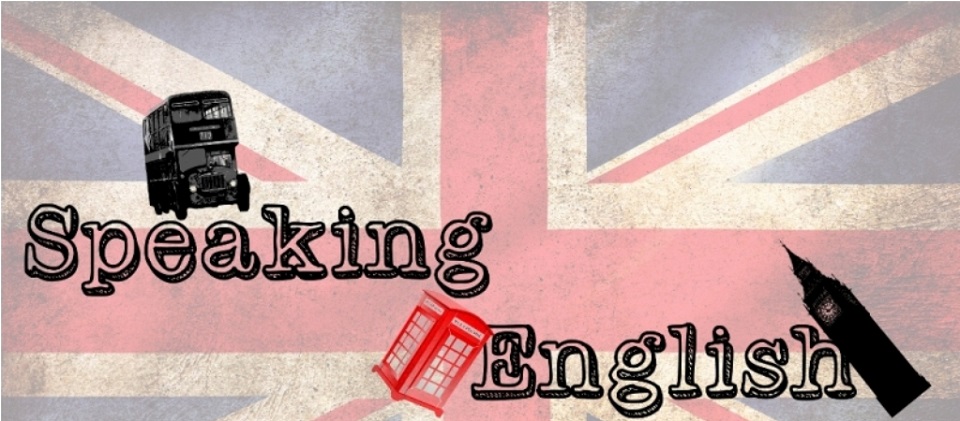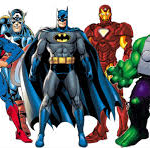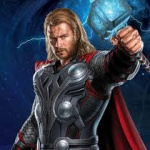By John Balasopoulos, Leo Papageorgopoulos & Takis Filtisenios (B class)
BATMAN
Batman is a fictional superhero appearing in American comic books published by DC Comics. The character was created by artist Bob Kane and writer Bill Finger,and first appeared in Detective Comics #27 (May 1939). Originally named «the Bat-Man», the character is also referred to by such epithets as the «Caped Crusader», the «Dark Knight«, and the «World’s Greatest Detective».
Batman’s secret identity is Bruce Wayne, an American billionaire, playboy, philanthropist, and owner of Wayne Enterprises. After witnessing the murder of his parents as a child, he swore revenge on criminals, an oath tempered by a sense of justice. Wayne trains himself both physically and intellectually and crafts a bat-inspiredpersona to fight crime. Batman operates in the fictional Gotham City, with assistance from various supporting characters, including his butler Alfred, police commissioner Jim Gordon, and vigilante allies such as Robin. Unlike most superheroes, Batman does not possess any superpowers; rather, he relies on his genius intellect, physical prowess, martial arts abilities, detective skills, science and technology, vast wealth, provocation of fear and intimidation, and an indomitable will. A large assortment of villains make up Batman’s rogues gallery, including his archenemy the Joker.
Batman became popular soon after his introduction and gained his own comic book title, Batman, in 1940. As the decades went on, differing interpretations of the character emerged. The late 1960s Batman television series used a camp aesthetic, which continued to be associated with the character for years after the show ended. Various creators worked to return the character to his dark roots, culminating in 1986 with The Dark Knight Returns by Frank Miller. The success of Warner Bros.“ live-action Batman feature films have subsequently helped maintain public interest in the character.
Creation
In early 1939, the success of Superman in Action Comics prompted editors at the comic book division of National Publications (the future DC Comics) to request more superheroes for its titles. In response, Bob Kanecreated «the Bat-Man». Collaborator Bill Finger recalled that «Kane had an idea for a character called “Batman,” and he’d like me to see the drawings. I went over to Kane’s, and he had drawn a character who looked very much like Superman with kind of … reddish tights, I believe, with boots … no gloves, no gauntlets … with a small domino mask, swinging on a rope. He had two stiff wings that were sticking out, looking like bat wings. And under it was a big sign … BATMAN». The bat-wing-like cape was suggested by Bob Kane, inspired as he was by Leonardo Da Vinci“s sketch of an ornithopter flying device as a child.
First image of Batman in Action Comics #12, announcing the character’s debut in the forthcomingDetective Comics #27
Finger suggested giving the character a cowl instead of a simple domino mask, a cape instead of wings, and gloves; he also recommended removing the red sections from the original costume.Finger said he devised the name Bruce Wayne for the character’s secret identity: «Bruce Wayne’s first name came from Robert Bruce, theScottish patriot, Chief of the Knights Templar. Bruce, being a playboy, was a man of gentry. I searched for a name that would suggest colonialism. I tried Adams, Hancock … then I thought of Mad Anthony Wayne.»[19] He later said his suggestions were influenced by Lee Falk“s popular The Phantom, a syndicated newspaper comic-strip character with which Kane was familiar as well.
Kane and Finger drew upon contemporary 1930s popular culture for inspiration regarding much of the Bat-Man’s look, personality, methods, and weaponry. Details find predecessors in pulp fiction, comic strips, newspaper headlines, and autobiographical details referring to Kane himself.[21] As an aristocratic hero with a double identity, the Bat-Man had predecessors in the Scarlet Pimpernel (created by Baroness Emmuska Orczy, 1903) and Zorro (created by Johnston McCulley, 1919). Like them, he performed his heroic deeds in secret, averted suspicion by playing the fool in public, and marked his work with a signature symbol. Kane specifically noted the influence of the films The Mark of Zorro (1920) and The Bat Whispers (1930) in the creation of the character’s iconography. Finger, drawing inspiration from pulp heroes like Doc Savage, The Shadow, Dick Tracy, and Sherlock Holmes, made the character a master sleuth.
(Source: https://en.wikipedia.org/wiki/Batman#Creation)
SPIDERMAN
Creation and development
In 1962, with the success of the Fantastic Four, Marvel Comics editor and head writer Stan Lee was casting about for a new superhero idea. He said the idea for Spider-Man arose from a surge in teenage demand for comic books, and the desire to create a character with whom teens could identify. In his autobiography, Lee cites the non-superhuman pulp magazine crime fighter the Spider (see also The Spider’s Web and The Spider Returns) as a great influence, and in a multitude of print and video interviews, Lee stated he was further inspired by seeing a spider climb up a wall—adding in his autobiography that he has told that story so often he has become unsure of whether or not this is true. At that time Lee had to get only the consent of Marvel publisher Martin Goodman for the character’s approval. In a 1986 interview, Lee described in detail his arguments to overcome Goodman’s objections. Goodman eventually agreed to a Spider-Man tryout in what Lee in numerous interviews recalled as what would be the final issue of the science-fiction and supernatural anthology series Amazing Adult Fantasy, which was renamed Amazing Fantasy for that single issue, #15 (cover-dated August 1962, on sale June 5, 1962). While this was indeed the final issue, its editorial page anticipated the comic continuing and that «The Spiderman [sic] … will appear every month in Amazing.»
Regardless, Lee received Goodman’s approval for the name Spider-Man and the «ordinary teen» concept, and approached artist Jack Kirby. As comics historian Greg Theakston recounts, Kirby told Lee about an unpublished character on which he had collaborated with Joe Simon in the 1950s, in which an orphaned boy living with an old couple finds a magic ring that granted him superhuman powers. Lee and Kirby «immediately sat down for a story conference», Theakston writes, and Lee afterward directed Kirby to flesh out the character and draw some pages. Steve Ditko would be the inker. When Kirby showed Lee the first six pages, Lee recalled, «I hated the way he was doing it! Not that he did it badly—it just wasn’t the character I wanted; it was too heroic». Lee turned to Ditko, who developed a visual style Lee found satisfactory. Ditko recalled:
One of the first things I did was to work up a costume. A vital, visual part of the character. I had to know how he looked … before I did any breakdowns. For example: A clinging power so he wouldn’t have hard shoes or boots, a hidden wrist-shooter versus a web gun and holster, etc. … I wasn’t sure Stan would like the idea of covering the character’s face but I did it because it hid an obviously boyish face. It would also add mystery to the character….
Although the interior artwork was by Ditko alone, Lee rejected Ditko’s cover art and commissioned Kirby to pencil a cover that Ditko inked. As Lee explained in 2010, «I think I had Jack sketch out a cover for it because I always had a lot of confidence in Jack’s covers.»
In an early recollection of the character’s creation, Ditko described his and Lee’s contributions in a mail interview with Gary Martin published in Comic Fan #2 (Summer 1965): «Stan Lee thought the name up. I did costume, web gimmick on wrist & spider signal.» At the time, Ditko shared a Manhattan studio with noted fetish artist Eric Stanton, an art-school classmate who, in a 1988 interview with Theakston, recalled that although his contribution to Spider-Man was «almost nil», he and Ditko had «worked on storyboards together and I added a few ideas. But the whole thing was created by Steve on his own… I think I added the business about the webs coming out of his hands.»
Amazing Fantasy #15 (Aug. 1962). The issue that first introduced the fictional character. It was a gateway to commercial success for the superhero and inspired the launch of The Amazing Spider-Man comic book. Cover art by Jack Kirby (penciller) andSteve Ditko (inker).
Kirby disputed Lee’s version of the story, and claimed Lee had minimal involvement in the character’s creation. According to Kirby, the idea for Spider-Man had originated with Kirby and Joe Simon, who in the 1950s had developed a character called the Silver Spider for the Crestwood Publications comic Black Magic, who was subsequently not used. Simon, in his 1990 autobiography, disputed Kirby’s account, asserting that Black Magic was not a factor, and that he (Simon) devised the name «Spider-Man» (later changed to «The Silver Spider»), while Kirby outlined the character’s story and powers. Simon later elaborated that his and Kirby’s character conception became the basis for Simon’s Archie Comics superhero the Fly. Artist Steve Ditko stated that Lee liked the name Hawkman from DC Comics, and that «Spider-Man» was an outgrowth of that interest.
(Source: https://en.wikipedia.org/wiki/Spider-Man)
THOR
As the Norse God of thunder and lightning, Thor wields one of the greatest weapons ever made, the enchanted hammer Mjolnir. While others have described Thor as an over-muscled, oafish imbecile, he’s quite smart and compassionate. He’s self-assured, and he would never, ever stop fighting for a worthwhile cause.
Real Name Thor Odinson
Height 6’6″; (Blake) 5’9″
Weight 640 lbs; (Blake) 150 lbs.
Powers As the son of Odin and Gaea, Thor’s strength, endurance and resistance to injury are greater than the vast majority of his superhuman race. He is extremely long-lived (though not completely immune to aging), immune to conventional disease and highly resistant to injury. His flesh and bones are several times denser than a human’s.As Lord of Asgard, Thor possessed the Odinforce, which enabled him to tap into the near-infinite resources of cosmic and mystical energies, enhancing all of his abilities. With the vast magical power of the Odinforce, Thor was even able to dent Captain America’s virtually indestructible shield with Mjolnir. Thor complete powers, Click here for complete list of Thor’s powers
Abilities Thor is trained in the arts of war, being a superbly skilled warrior, highly proficient in hand-to-hand combat, swordsmanship and hammer throwing.







